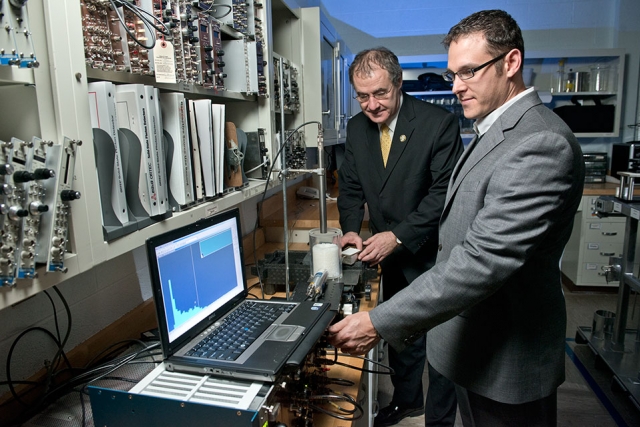What’s a Fellow to do?
 Ashley Stowe (right) partners with Arnold Burger of Fisk University and other local universities and commercial partners to advance technologies that support Y‑12’s missions.
Ashley Stowe (right) partners with Arnold Burger of Fisk University and other local universities and commercial partners to advance technologies that support Y‑12’s missions.
Ashley Stowe spent two years as Y‑12's Technology Fellow. During that time, he took a deep dive into the neutron detection work he’d begun with LISe™ (pronounced "Lisa"), the R&D 100 Award‑winning high‑efficiency thermal neutron detector. Stowe’s special assignment ultimately expanded use of the neutron detection crystal to other applications and further refined it for Y‑12’s mission work.
“New solid state radiation detectors are needed for nuclear nonproliferation and global security applications to find and secure nuclear materials and to keep the world safe,” said Stowe, the lead functional manager for sciences within Mission Engineering. LISe is sensitive and compact, opening the door to create better solutions.
“Ten years ago, radiation‑detection devices were as big as basketballs. Now, they’re significantly smaller. In fact, the LISe detector can be as small as the size of two nickels on top of each other,” Stowe said. “Compact radiation‑detection crystals offer a great advantage because they can be used much more easily in hand‑held and radiography applications. The high neutron sensitivity and small size allow us to find neutron signatures without the complications of gamma‑ray interference, which masks or confuses many detectors.”
With LISe as his launch point, Stowe explored a myriad of potential applications for the 6LiInSe2 crystal on which LISe is based. He authored 14 publications and gave 20 presentations worldwide on topics covering:
• neutron imaging in which the crystal acts like a photo plate;
• space applications, measuring neutron flux in the atmosphere;
• space experimentation to determine the feasibility of putting colonies in the atmospheres of other planets and
• astromining, looking in space for precious minerals such as helium or gold.
In his research, Stowe works closely with Vanderbilt University, Fisk University, the University of Tennessee‑Knoxville and commercial associates. “The fellowship certainly was a rich experience because it gave me the opportunity to fully explore the potential of LISe and engage local universities and commercial partners,” Stowe said. “Working together we discovered a second way LISe responds to radiation and built a prototype neutron imager with world‑class spatial resolution. That feat was recognized as a 2015 R&D 100 finalist.”
Since Stowe finished his fellowship work in late 2015, he has spearheaded the effort to update and expand Y‑12’s Technology Fellowship program. His experience will be integral in standing up the next iteration of the program.
“A key aspect of the new Consolidated Nuclear Security Fellows Program is the opportunity to develop collaborative partnerships with both universities and private industry to not only expand expertise, capabilities and research agility but also to showcase and pursue funding opportunities related to the development of the technology,” said Matt Smith of Y‑12’s Technology Development and Transfer office.
Stowe, who holds a doctorate in chemistry as well as a master’s degree in business administration, has four patents and a suite of six additional patents (in process with the U.S. Patent Office) related to the LISe technology.
